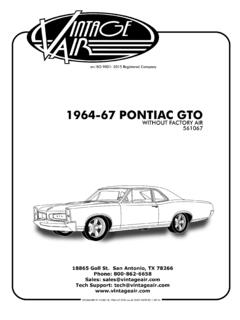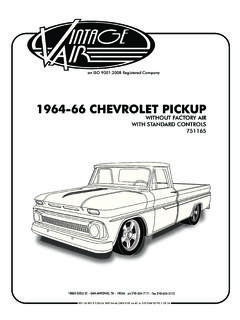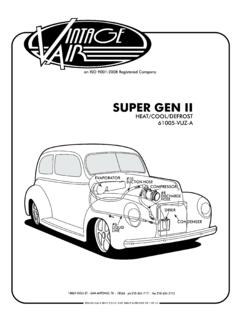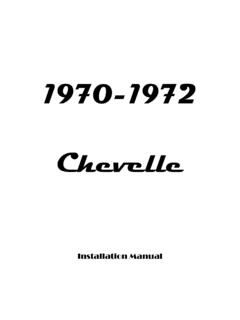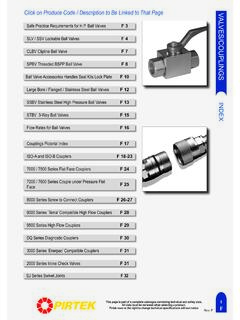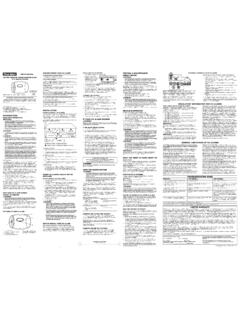Transcription of 1955-56 Chevrolet Full-Size - Vintage Air
1 An ISO 9001:2015 Registered Company 1955 -56 Chevrolet Full-Size Evaporator Kit (56155-PCZ). 18865 Goll St. San Antonio, TX 78266. Phone: 800-862-6658. Sales: Tech Support: 906155-PCZ REV H 05/05/21, PG 1 OF 27. Table of Contents 1. Table of 2. Packing List/Parts 3. Information 4. Wiring 5. Engine Compartment Disassembly, Passenger Compartment 6. Condenser Assembly Installation, Core Support 7. Compressor and Brackets, Pulleys, Defrost Duct Installation, Control Panel 8. Evaporator 9. Evaporator Installation (Cont.).. 10. Evaporator Installation (Final).. 11. Under dash Louver Installation, Drain Hose 12. Lubricating O-rings, Heater Control Valve 13. A/C Hardline and Hose Installation, Liquid Line and Binary Switch 14. A/C and Heater Hose 15. Firewall Cover 16. Wiring Installation.. 17. Duct Hose 18. Glove Box Installation, Final 19. Evaporator Hardline 20. Wiring 21. Gen IV Wiring Connection 22.
2 Operation of 23. Troubleshooting 24. Troubleshooting Guide (Cont.).. 25. Core Support Modification 26. Packing 27. 2 906155-PCZ REV H 05/05/21, PG 2 OF 27. Packing List: Evaporator Kit (56155-PCZ). No. Qty. Part No. Description 1. 1 760155-VCE Gen IV Evaporator Sub Case 2. 1 78255-PCN Accessory Kit ** Before beginning installation, open all packages and check contents of shipment. Please report any shortages directly to Vintage Air within 15 days. After 15 days, Vintage Air will not be responsible for missing or damaged items. 1. Gen IV Evaporator Sub Case 760155-VCE. 2. Driver Side Passenger Side Accessory Kit NOTE: Images may not depict actual parts and quantities. 78255-PCN Refer to packing list for actual parts and quantities. 3 906155-PCZ REV H 05/05/21, PG 3 OF 27. Important Notice Please Read For Maximum System Performance, Vintage Air Recommends the Following: NOTE: Vintage Air systems are designed to operate with R134a refrigerant only.
3 Use of any other refrigerant could damage your A/C system and/or vehicle, and possibly cause a fire, in addition to potentially voiding the warranties of the A/C. system and its components. Refrigerant Capacities: Vintage Air System: lbs. ( oz.) or 816 grams of R134a, charged by weight with a quality charging station or scale. NOTE: Use of the proper type and amount of refrigerant is critical to system operation and performance. Other Systems: Consult manufacturer's guidelines. Lubricant Capacities: New Vintage Air-Supplied Sanden Compressor: No additional oil needed (Compressor is shipped with proper oil charge). All Other Compressors: Consult manufacturer (Some compressors are shipped dry and will need oil added). Safety Switches Your Vintage Air system is equipped with a binary pressure safety switch. A binary switch disengages the compressor clutch in cases of extreme low pressure conditions (refrigerant loss) or excessively high head pressure (406 PSI) to prevent compressor damage or hose rupture.
4 A trinary switch combines Hi/Lo pressure protection with an electric fan operation signal at 254 PSI, and should be substituted for use with electric fans. Compressor safety switches are extremely important since an A/C system relies on refrigerant to circulate lubricant. Service Info: Protect Your Investment: Prior to assembly, it is critical that the compressor, evaporator, A/C hoses and fittings, hardlines, condenser and receiver/drier remain capped. Removing caps prior to assembly will allow moisture, insects and debris into the components, possibly leading to reduced performance and/or premature failure of your A/C system. This is especially important with the receiver/drier. Additionally, when caps are removed for assembly, BE CAREFUL! Some components are shipped under pressure with dry nitrogen. Evacuate the System for 35-45 Minutes: Ensure that system components (Drier, compressor, evaporator and condenser) are at a temperature of at least 85 F.
5 On a cool day, the components can be heated with a heat gun or by running the engine with the heater on before evacuating. Leak check and charge to specifications. Bolts Passing Through Cowl and/or Firewall: To ensure a watertight seal between the passenger compartment and the vehicle exterior, for all bolts passing through the cowl and/or firewall, Vintage Air recommends coating the threads with silicone prior to installation. Heater Hose (not included with this kit): Heater hose may be purchased from Vintage Air (Part#31800-VUD) or your local parts retailer. Routing and required length will vary based on installer preference. 4 906155-PCZ REV H 05/05/21, PG 4 OF 27. Important Wiring Notice Please Read Some vehicles may have had some or all of their radio interference capacitors removed. There should be a capacitor found at each of the following locations: 1. On the positive terminal of the ignition coil.
6 2. If there is a generator, on the armature terminal of the generator. 3. If there is a generator, on the battery terminal of the voltage regulator. Most alternators have a capacitor installed internally to eliminate what is called whining as the engine is revved. If whining is heard in the radio, or just to be extra cautious, a radio interference capacitor can be added to the battery terminal of the alternator. It is also important that the battery lead is in good shape and that the ground leads are not compromised. There should be a heavy ground from the battery to the engine block, and additional grounds to the body and chassis. If these precautions are not observed, it is possible for voltage spikes to be present on the battery leads. These spikes come from ignition systems and charging systems, and from switching some of the vehicle's other systems on and off. Modern computer-operated equipment can be sensitive to voltage spikes on the power leads, which can cause unexpected resets, strange behavior and/or permanent damage.
7 Vintage Air strives to harden our products against these types of electrical noise, but there is a point where a vehicle's electrical system can be degraded so much that nothing can help. Radio interference capacitors should be available at most auto and truck parts suppliers. They typically are cylindrical in shape, a little over an inch long and a little over a half-inch in diameter, and they have a single lead coming from one end of the cylinder with a terminal on the end of the wire, as well as a mounting clip which is screwed into a good ground on the vehicle. The specific value of the capacitance is not too significant in comparison to ignition capacitors that are matched with the coil to reduce pitting of the points. Care must be taken, when installing the compressor lead, not to short it to ground. The compressor lead must not be connected to a condenser fan or to any other auxiliary device.
8 Shorting to ground or connecting to a condenser fan or any other auxiliary device may damage wiring or the compressor relay, and/or cause a malfunction. When installing ground leads on Gen IV systems, the blower control ground and ECU. ground must be connected directly to the negative battery post. For proper system operation, the heater control valve must be connected to the ECU. 5 906155-PCZ REV H 05/05/21, PG 5 OF 27. Engine Compartment Disassembly NOTE: Before starting the installation, check the function of the vehicle (horn, lights, etc.) for proper operation, and study the instructions, illustrations, & diagrams. Perform the Following: 1. Disconnect battery. 2. Remove battery and battery tray. 3. Remove air cleaner. 4. Drain radiator. 5. Disconnect heater hoses. Passenger Compartment Disassembly Perform the Following: 1. Remove the OEM heater assembly by removing the control cables, along with (2) 7/16 nuts on the firewall and (1) under the dash (discard).
9 2. Remove the heater blower (discard) (See Figure 1, below). 3. Remove the butterfly duct above the kick panel vent, as well as the panel flange (discard). Install the new vent cover as shown in Figure 2, below. 4. Remove the glove box door (retain). 5. Remove the glove box (discard). 6. Remove the original defrost duct from the heater to the windshield (discard). 7. Remove the ash tray (retain). 8. Remove the ash tray slider assembly (retain). 9. Remove the vent and cables from the dash (retain) (See Figure 1, below). 10. Remove the control panel (retain). 11. Remove the passenger side speaker grille (retain) (See Figure 1, below). 6. OEM. Screws 11. Figure 2. 5. 2. 8. 7. 4. Figure 1 1. 3. 6 906155-PCZ REV H 05/05/21, PG 6 OF 27. Condenser Assembly Installation 1. Loosen the (6) bolts that secure the radiator to the core support. 2. Slide the condenser assembly into position. The condenser brackets will be held between the radiator and the core support.
10 Secure with the (6) radiator bolts (See Figures 3 & 3b, below). Holding the condenser in position, tighten the (6) radiator bolts. Core Support Modification 1. Locate the core support modification template on Page 26, and align the template on the passenger side of the core support panel. Using the template, mark holes and cut a 1 hole using a hole saw. Drill a 5/16 hole in the noted location (See Figure 3a, below). 2. Install the #6 and #8 condenser hardlines through the 1 hole. Lubricate a #6 and #8 O-ring as shown in Figure 9, Page 13, and connect the #6 and #8 condenser hardlines to the condenser. 3. Locate the split grommet and install as shown in Figure 3b, below. 4. Install the drier loosely as shown in Figure 3b, below. NOTE: Refrigerant flow follows the arrow on the drier. OEM Radiator Side of Core Vintage Air Support Condenser Hole in Core Support NOTE: #8 (Larger). 1/4 Nut with Fitting is at Top of Flat Washer Radiator.
